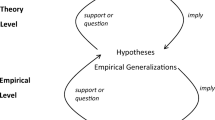Abstract
Hall [(2007), Philosophical Studies, 132, 109–136] offers a critique of structural equations accounts of actual causation, and then offers a new theory of his own. In this paper, I respond to Hall’s critique, and present some counterexamples to his new theory. These counterexamples are then diagnosed.













Similar content being viewed by others
Notes
The account of Yablo (2002) works similarly.
Hall says that a variant must be nomologically possible, but this seems too weak. It may be that the particular pattern of dependence represented in a neuron diagram such as Fig. 1 is in place, in part, because of additional factors that are being held fixed in the background. Thus it may be nomologically possible for C to fire and D not to fire, if, for example, the connection between them is disrupted. In the framework of structural equations models, what we really want is for the equations for endogenous variables to remain constant. In Pearl’s terminology, a variant must have the same mechanisms as the original causal structure.
If an object or system has more than one deviant behavior, it may also differ with respect to which deviant behavior it engages in.
The informal version of the structural equations account described above will get this case wrong, but the more elaborate account of Halpern and Pearl (2005) will get it right. The details of this more elaborate account need not distract us.
Although I think there is a genuine issue of whether to represent the intermediate state of the system using one variable or two. See the parallel discussion of the dog bite example in Hitchcock (2001, Sect. VII).
Indeed, the reader may easily verify that this is the only non-trivial reduction of the system shown in Fig. 6 in which F and E both fire.
Nor will it help, for example, to require for causation that counterfactual dependence hold in every non-trivial reduction in which F and E fire, or to require that the counterfactual dependence not be eliminated by taking further reductions; for, as we remarked in the previous footnote, Fig. 7 represents the only non-trivial reduction of the system shown in Fig. 6 where F and E both fire.
For further discussion, see Hitchcock (2007b).
See Glymour et al. MS for an enlightening discussion of the combinatorial possibilities.
For comments and suggestions, I would like to thank Alison Gopnik, Ned Hall, Joe Halpern, Jim Woodward, Jiji Zhang, and an anonymous referee for Philosophical Studies.
References
Glymour, C., Danks, D., Glymour, B., Eberhardt, F., Ramsey, J., Scheines, R., Spirtes, P., Teng, C., & Zhang J. (2007). MS. Actual causation: A stone soup essay.
Hall, N. (2004). Two concepts of causation. In J. Collins, N. Hall, & L. Paul (Eds.), Causation and counterfactuals (pp. 225–276). Cambridge, MA: M.I.T. Press.
Hall, N. (2007). Structural equations and causation. Philosophical Studies, 132, 109–136.
Halpern, J., & Pearl, J. (2005). Causes and explanations: A structural-model approach. Part I: Causes. British Journal for the Philosophy of Science, 56, 843–887.
Hitchcock, C. (2001). The intransitivity of causation revealed in equations and graphs. Journal of Philosophy, 98, 273–299.
Hitchcock, C. (2007a). Prevention, preemption, and the principle of sufficient reason. Philosophical Review, 116, 495–532.
Hitchcock, C. (2007b). What’s wrong with neuron diagrams. In J. Campbell, M. O’Rourke, & H. S. Silverstein (Eds.), Causation and explanation (pp. 69–92). Cambridge MA: M.I.T. Press.
Pearl, J. (2000). Causality: Models, reasoning, and inference. Cambridge: Cambridge University Press.
Woodward, J. (2003). Making things happen: A theory of causal explanation. Oxford: Oxford University Press.
Yablo, S. (2002). De facto dependence. Journal of Philosophy, 99, 130–148.
Author information
Authors and Affiliations
Corresponding author
Rights and permissions
About this article
Cite this article
Hitchcock, C. Structural equations and causation: six counterexamples. Philos Stud 144, 391–401 (2009). https://doi.org/10.1007/s11098-008-9216-2
Received:
Accepted:
Published:
Issue Date:
DOI: https://doi.org/10.1007/s11098-008-9216-2




